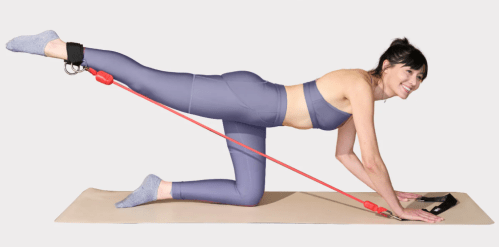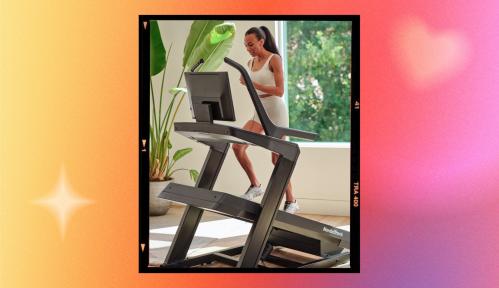Our editors independently select these products. Making a purchase through our links may earn Well+Good a commission
I’m a Pilates Instructor, and This Smart Resistance Band System Is Like Having an At-Home Reformer That Fits in a Shoebox
I’m a Pilates instructor and LIT Axis let’s me do most of the exercises I’d teach on a reformer for a fraction of the cost and footprint.

Like lots of people, over the past few years, I’ve thought about bringing more workout equipment into my home now that I’ve adopted a hybrid fitness routine and spend about as much time working out in my living room as I do in a gym or studio. I live in a 600-square-foot apartment in New York City, so the idea of rearranging my furniture to make room for an exercise machine is not a decision to be taken likely. The only one I’d even think of ceding floor space to is a Pilates reformer.
At one point during the pandemic, I seriously considered getting rid of my couch to make room for one so that I could continue the almost daily reformer practice I’ve had for the past seven years. A six-month wait list for the model I wanted stopped me, fortunately—turns out, I kinda like having something soft to sit on.
Even after my studio reopened and I was able to go back to taking reformer lessons in person, I still found the idea of having a machine at home appealing so that I could test and develop new routines, since I teach group reformer classes a couple days a week.
So when my editor asked if I’d be interested in trying out LIT Axis, a smart resistance band system designed to offer a Pilates reformer-esque experience at home—minus the large footprint, and for a fraction of the cost—I was intrigued… and a little bit skeptical. There are so many moving parts to a Pilates reformer (which was originally developed by Joseph Pilates in the 1910s) that I couldn’t really wrap my mind around how you could replicate it without all the pulleys and springs.
Unboxing the LIT Axis system
When I got the tracking update that my LIT Axis system ($199) was out for delivery, I made sure to be home to receive it because I assumed the box would be big enough to block the entryway in my building. After buzzing in my FedEx guy, I opened my door and was surprised to be handed a package that wasn’t much bigger than a shoebox and light enough to hold in my palm.
Inside was a white, soft-shell case that contained two sets of smart resistance bands (15 and 30 pounds), a pair of ankle cuffs, two handles, and an anchor strap, which you could either wrap around a heavy, stationary object in your home or wedge into the hinge side of your doorframe.
To activate my system, I downloaded the LIT Method app to my iPad (there’s only an iOS version) and logged into the membership I’d be given as part of my trial. Normally, in addition to the one-time cost for purchasing the system, you’d also need a membership, which costs $10 a month or $80 a year.

LIT Axis — $199.00
Plus $10 a month or $80 a year for the membership
The resistance bands are bluetooth-enabled so they can track your reps. There are instructional videos in the app, as well as a pamphlet inside the box to help walk you through the setup process, which took me less than 10 minutes.
From there, all that was left to do was fire up one of the videos. There are dozens of follow-along workouts to choose from, ranging from 10 to 30 minutes and organized by experience level: beginner, intermediate, or advanced.
Anchors away
Depending on what workout you choose, you’ll need to either anchor the system at about floor level (like around the leg of a table) or hip height. The first video I queue up is a 10-minute, lower-body Pilates class that requires a floor anchor that I attach to the base of my lululemon Studio mirror since it’s the heaviest thing in my house.
After a quick dynamic warm-up, we attach our ankle cuffs, which I’ve connected to the 15-pound resistance bands, and get down on all fours for some glute work. We cycle through kickbacks (bending and extending our legs behind us), followed by leg lifts, and then finish with some pulses before moving to the second side. It’s a series I’ve done and taught several times, and feels the same as it does on the reformer, with one exception: Because I’m performing the exercises on the floor instead of a moving carriage, I don’t find that it challenges my stability or core as much.
Next, I try a 10-minute, total-body Pilates class that requires a hip-height anchor, so I move over to my front door (the only one I have in my apartment with a hinge). I feel a little weird about having half the anchor, which looks like a black security strap, hanging out into the hallway, but it feels way more secure to me than when it was around the base of my mirror.
This time, we start with leg circles, an exercise anyone who practices reformer Pilates will be familiar with. After looping the ankle cuffs around the arches of my feet, I start to draw large circles with my legs in one direction, followed by the other.
Next, it’s on to double leg extensions. Starting with my legs in tabletop, I extend them to straight on a 45-degree angle pressing against the resistance of the bands. I opted to stick with the 15-pound bands for this workout as well because, while I feel like I could have used the 30-pound ones for the lower-body portion, I knew they’d be too heavy to perform arm work with, which we move on to next.
Popping up on my knees and facing away from the door, I slip my hands into each ankle cuff, flip my palms up toward the ceiling, and begin to bend and extend my elbows, reaching my arms in front of me as if I’m serving someone something on a platter. Again, this is the exact type of move I’d do on the reformer, and the only difference is the lack of instability afforded by the machine, which makes it harder to keep your balance as you move back and forth.
Once I’m finished, I pack all the equipment back into its case, move my furniture back into place, and have my living room in one piece again in less than five minutes.
How the LIT Axis system compares to a reformer
I’ve only taken a couple classes, but I can already tell that once I figure out a good anchor system, I’m going to be using the LIT Axis a lot at home to practice my reformer technique. I would not go so far as to say that it’s a perfect substitute for the real thing, but it’s definitely a great complement.
Much of the formatting for LIT’s Pilates classes is similar to what I’d teach on a reformer. In some ways though, I’d say it’s more similar to a Pilates cadillac than a reformer you’d find in group classes since it doesn’t have a moving carriage.
On a reformer, resistance is determined by spring choice: light, medium, and heavy, or a combo thereof, which aren’t translated into weight measurements. By comparison, the LIT system only has two resistance options, which feel to me like medium and heavy springs. The average person will probably be fine with just these two levels of resistance, but a lighter resistance option may be necessary for people who are new to Pilates and don’t have the strength to move as much load yet. A lighter option is also nice for core work and single-arm movements that focus more on smaller stabilizer muscles like our rotator cuffs, for example, or mobility moves that require a large range of motion (like arm circles).
Even at a point where it’s now possible to get your hands on Pilates reformers for home use, I feel like I would opt to go with the LIT Axis system since you can also use it as a cable system or suspension trainer, so it really feels like you’re getting a lot out of something that takes up about as much space as a pair of dumbbells. Plus, it doesn’t require me getting rid of any furniture to make room for it.
Sign up for the Well+Good SHOP Newsletter
Get exclusive deals on wellness, beauty, fitness, and food products that have been hand-picked by our editors.
Got it, you've been added to our email list.










